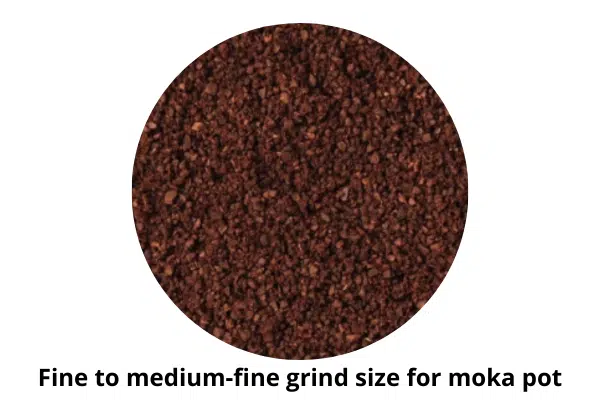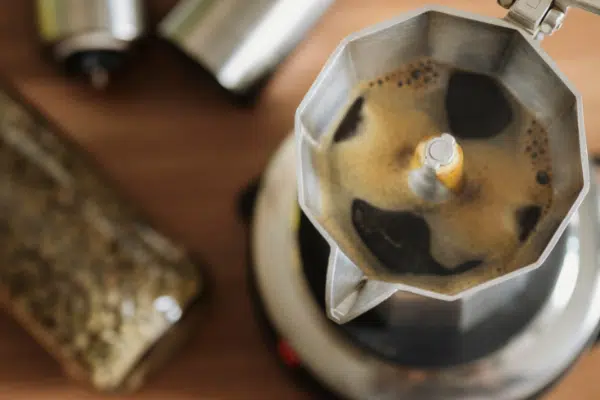How To Grind Coffee For Moka Pot; A Barista Weighs In
Disclosure: This post contains affiliate links and I may earn a small commission (at no extra cost to you) if you click through and make a purchase. Thanks in advance – I really appreciate it!
Did you know that with a little experimentation, you can use a moka pot to make specialty coffee and even recreate popular coffee shop beverages? Well, that’s the reason I purchased my first moka pot. Then I was faced with the dilemma that every new moka pot user faces – Figuring out the perfect grind size for moka pot brewing.
Key Takeaways:
How to grind coffee for moka pot?
The moka pot brewing method calls for a consistent fine to medium-fine coffee grind size. The best coffee grind size for moka pot is finer than coffee grounds used for pour-over, but not quite as fine as the grounds used for making espresso.

Whether you’ve just picked up a moka pot or have had one for years, read on to learn more about the best grind size, perfect coffee to water ratio for moka pot, and many more tips and tricks that will help you brew a well-balanced cup of coffee in your moka pot.
What is the Best Grind Size for Moka Pot
When making coffee in a moka pot, you should use fine to medium-fine coffee grind size. The coffee grounds used in moka pot brewing are smaller than granulated sugar but closer in texture to table salt.
But, how do you know that it is the best grind size for moka pot?
An easy test is to pinch the grinds between your thumb and forefinger. Where the pressure is greatest, in the center of the pinch, the coffee should clump a little. If it doesn’t clump at all, it’s too coarse and will make a weak shot. If it clumps excessively, it’s too fine and will produce over-extracted coffee.
Why Does Grind Size Matter for Moka Pot Brewing
When it comes to coffee grind size, there are three factors that make the biggest difference: contact time, extraction rate, and flow rate.
Here’s a simpler explaination:
The extraction rate of coffee grounds increases with a larger surface area.
To increase surface area, grind the coffee finer.
The higher the extraction rate, the less contact time is needed.
A finer grind can reduce the flow rate of water, increasing the contact time.
For example, an extra coarse grind is best for cold brewing methods because it’s brewed for a long period of time. Drip brewing methods, as you’d find in your typical auto-drip coffee maker, is best with medium grinds.
If your contact time (how long your coffee brews) is too long and the grind is too fine, you’ll most likely over-extract the brew and make your coffee bitter. On the other hand, if the grind is too coarse and the contact time is short, the coffee will turn out weak.
You should grind your coffee beans to a fine to medium-fine grind size for brewing in a moka pot because the contact time is quite short and the pressure (approximately 1.5 bar) is a bit higher than your typical drip coffee brewer but much lower than the pressure (9 bar) used in an espresso machine.
Bear in mind too that the freshness of the roasted beans and their degree of roast impact how the water is absorbed so these are factors that affect grind as well.

Can You Use Coarse Grind For Moka Pot?
Coffee grounds used in a moka pot should be coarser than espresso grinds and finer than the grinds used in pour-over brewing. Since the contact time of coffee grinds with water is quite short, if the grounds used in a Moka pot are too coarse, the coffee will turn out to be weak and under-extracted.
A Moka pot is designed to completely saturate the coffee grounds while building pressure to arrive in its top chamber. This saturation gives the brew its rich taste.
Your coffee grind size plays a valuable part in the brewing process and contributes to the overall flavor and smoothness of the final cup.
Using a coarser grind for brewing coffee in a moka pot can give you weak, watery, or sour-tasting coffee that is highly acidic. On the other hand, if your grind is too fine, your coffee will taste burnt and bitter from over-extraction.
Can You Use Regular Ground Coffee In A Moka Pot?
Coffee grounds used in a moka pot should be finer than regular ground coffee but coarser than espresso grinds. Moka pot has a shorter brew time, that is why it is important to use a fine grind so the water is able to extract as much flavor as possible from the grinds in its short contact time.
The regular coffee grounds are generally medium-fine grind size which is ideal for pour-over and drip coffee machines. But, the moka pot brewing method, due to its shorter brew time and a pressure of 1.5 bar calls for a fine to medium-fine coffee grind size for optimum extraction of coffee flavors.
Best Grinder Settings For Moka Pot
Of everything you might encounter when brewing coffee at home, grinding coffee is arguably one of the most crucial steps, as grind size alone can dramatically change the taste of your cup. Grind size and consistency can be the difference between one of the best cups you’ve ever had and a bitter, undrinkable mess.
To help you efficiently grind your own fresh coffee on the spot, below is a table that lists the moka pot grinder settings of the most common burr grinders. If you don’t own a grinder yet, then make sure that you go through the next section of this article where I list down a few best grinders for moka pot brewing.
| Grinders | Grind Setting |
|---|---|
| Baratza Encore | 4 - 16 |
| Baratza Virtuoso | 4 - 16 |
| Baratza Vario | 1- 4 |
| Capresso Infinity | 2 - 6 |
| Cuisinart Supreme Grind | 2 - 7 |
| Bodum Bistro | 1 - 6 |
| OXO Brew Burr Grinder | 1 - 6 |
| Hario V60 | 4 - 18 |
| KRUPS Burr Grinder | 2 - 7 |
The Best Moka Pot Coffee To Water Ratio
Making good coffee in your moka pot can come down to some pretty fine details, including the size of the ground coffee particles, the temperature of your water, and brewing duration.
But, what is the best moka pot coffee to water ratio?
Moka pot brewing method calls for a 1:13 coffee to water ratio. In other words, for every 1 gram of coffee grounds, use 13 grams of water. For a three-cup moka pot, you will need about 13 grams ( 2 tablespoons) of fine to medium-fine ground coffee for 170 grams of water.
Strength is determined by the ratio of coffee to water, increasing the amount of coffee increases the strength. Ultimately strength comes down to a matter of personal taste and there is no right or wrong choice.
Since every moka pot has a different size, the general moka pot best practice is filling the filter basket completely with coffee and filling the boiler up to the fill line with water. If there is no fill line, fill the boiler up to the bottom of the relief valve. This means your brewing ratios are pretty much set. The only things you have to fiddle with are grind size and heating technique.
A coffee scale is a great tool for the coffee brewing process that can help you massively to get the ratio exactly right and make the same cup of coffee every day.
Moka Pot Coffee To Water Ratio Chart
Below is a simple chart that can help you in figuring out the amount of coffee that you should use according to the size of your moka pot.
| Moka Pot Size | Water (grams) | Coffee (grams) | Coffee (tablespoons) |
|---|---|---|---|
| 1-Cup | 57 (2 oz.) | 4.5 | 0.8 |
| 2-Cup | 114 (4 oz.) | 8.8 | 1.8 |
| 3-Cup | 170 (6 oz.) | 13 | 2 |
| 4-Cup | 228 (8 oz.) | 17.5 | 2.5 |
| 6-Cup | 355 (12 oz.) | 27.3 | 4.3 |
| 8-Cup | 455 (16 oz.) | 35 | 5 |
| 9-Cup | 510 (18 oz.) | 36 | 6 |
| 10-Cup | 567 (20 oz.) | 44 | 7 |
| 12-Cup | 710 (25 oz.) | 55 | 8.5 |
Tips For Brewing With A Moka Pot
Here are a few tips that you can follow to improve the way you brew coffee with a moka pot.
- Choose the right size moka pot. Keep in mind that you can’t half-fill a moka pot, so don’t buy a 6-cup moka pot thinking you will only make 3-cups worth every now and then. They really only work well when filled appropriately.
- Most moka pots have a safety valve in the bottom chamber, if you fill water past this level, too much pressure will build up.
- Use fine to medium-fine grind size, finer than you would for pour-over, but not as fine as espresso. Using a grind size that is fine enough for espresso will lead to over-extraction and a bitter cup.
- Do not tamp the coffee grounds in a moka pot. with a moka pot as it causes channeling. Channeling occurs where the water passes through gaps or “channels” in the ground coffee bed, rather than saturating the puck evenly. This causes under-extraction.
- Fill the lower chamber with freshly boiled hot water. This will speed up extraction, prevent the coffee from burning, and keep the brew from developing a metallic taste.
- Always place your moka pot on the stove on a medium-low heat setting. As it brews, leave the lid open so you can keep an eye on it.
- Once the moka pot starts making bubbling noises, take it off the heat immediately and close the lid, then leave it for a minute or so to allow it to finish brewing.
How To Brew Coffee in a Moka Pot
The moka pot, in theory, functions similarly to espresso machines. Both use pressure to push heated water through ground coffee. The difference, however, is that the moka pot pushes the brew upwards, and does not use high-pressure water to achieve the shorter brew times of an espresso machine. This means that while the moka pot does not produce espresso, it still creates a rich, heavy, and intense cup.
Here’s what you’ll need:
- Roasted Coffee Beans
- Moka Pot
- Hot Water
- Burr Coffee Grinder
- Cup or Carafe
Step 1: Preheat the water. Bring kettle water to a boil and remove from heat.
Step 2: Grind enough coffee to fill the coffee basket all the way up at a fine to a medium-fine setting. Level the grounds with a knife. Do not tamp the grounds.
Step 3: Fill the bottom chamber of the moka pot with water until it touches the bottom of the valve.
Step 4: Insert the filter basket into the brewer’s bottom.
Step 5: Screw the moka pot’s spouted top on tightly.
Step 6: Put the moka pot on the stove over medium-low heat and make sure that the handle is not subjected to heat. Leave the top lid open.
Step 7: As the water in the bottom chamber approaches a boil, the pressure will push a stream of coffee steadily up into the upper chamber. You know it’s done when you hear a hissing, gurgling sound.
Step 8: When the coffee is about 80% of the way up to the spout (or it looks like yellow honey), take it off the burner and put it directly onto the cold towel or run under cold tap water to stop extraction.
Step 9: As soon as the coffee stops bubbling out, pour it into cups or a carafe. You may wish to dilute with hot water depending on your preference.
Frequently Asked Questions
Why is my moka pot coffee sour?
Your moka pot coffee is sour because the coffee grounds were too coarse. To fix this, grind the coffee a little finer next time.
Why is my moka pot coffee bitter?
If your moka pot coffee is too bitter, it means you over-extracted from the grounds. To fix this, use a slightly coarser grind setting and stop the brewing a few seconds earlier. Also, use a lower heat setting.
Why is my moka pot coffee too weak and watery?
If the coffee is too weak, it’s likely that the water vapor is forming channels in the grounds which leads to uneven extraction from small parts of the grounds. To fix this, gently tap the filter basket few times to distribute the grounds more evenly next time. You may also need to use a finer grind to boost extraction.
Why does my moka pot coffee taste burnt?
If your moka pot coffee tastes burnt, this generally means that you might be keeping the brewer on the heat for too long. To fix this, try taking your moka pot off of the heat sooner. Make sure you are removing your coffee from the moka pot as soon as possible.

Amit Gupta
Hi, my name is Amit Gupta, and I am the owner and contributor at Cafeish. My obsession with coffee started when I received my first French press as a gift almost ten years ago. Since then, my love of coffee – and the number of coffee gadgets I own – has grown considerably.
Most Popular
ABOUT US
We are a team of coffee affcianados with experience and expertise in making world renowned coffee. In fact, preparing the best coffee ever with a fluffy top reminds us of magic, with secrets of how to achieve each particular effect. Making coffee is not our only hobby, we always keep our ears open as to what’s happening around and what scientists and manufacturers produce for consumers. It’s not an easy task to do – it’s rather time consuming. Hence, Caféish website was launched.
LEGAL DISCLAIMER
Caféish is a participant in the Amazon Services LLC Associates Program, an affiliate advertising program designed to provide a means for sites to earn advertising fees by advertising and linking to Amazon.com. Caféish also participates in affiliate programs with Clickbank and other sites. Caféish is compensated for referring traffic and business to these companies.




